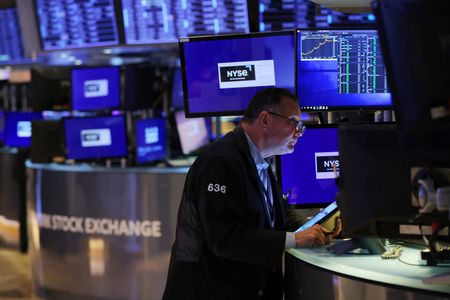By Davide Barbuscia
NEW YORK (Reuters) – Expectations of how aggressively the Federal Reserve will raise rates in its fight against inflation hit a fresh high this week, exacerbating pressures on stocks and bonds.
As investors await another jumbo rate increase from the U.S. central bank at its Sept. 20-21 meeting, higher-than-expected inflation numbers have ramped up bets on the so-called terminal rate, which now stand at 4.45%, Refinitiv data showed.
That is more than 200 basis points higher than the current benchmark overnight interest rate and compares with a projected peak of about 3.7% just a month ago.
Higher U.S. interest rates are potentially unwelcome for stocks, which rallied over the summer, while bond yields, which move inversely to prices, retreated from their highs on hopes that the Fed would ease the pace of rate hikes.
Those hopes were dashed this week when the U.S. consumer price index (CPI) for August showed inflation rose 8.3% on an annualised basis, more than economists’ forecasts of 8.1%.
“I think the Fed is going to put another 150 basis points to 200 basis points of rate hikes into the market, but it’s the speed with which they do it which is the debate at this point,” Jeffrey Sherman, deputy chief investment officer at DoubleLine, said.
Expectations of a more hawkish Fed have also boosted real yields, which show how much an investor can make on an annualised basis holding a U.S. government bond and dull the allure of riskier assets when they rise.
Yields on the 10-year Treasury Inflation-Protected Securities (TIPS) – known as real yields because they strip out projected inflation – climbed to 1.03% on Friday, their highest since January 2019. Since the beginning of August, real yields have gone up by about 100 bps.
Meanwhile benchmark 10-year Treasury yields have climbed about 8 basis points this week to 3.443%, flirting with a new 11-year high if they go above the 3.495% level they hit in June. Goldman Sachs said in a note on Friday those yields could end the year at 3.75%.
The picture is not any rosier for corporate debt.
“Investors don’t appear to have much confidence in the Fed’s ability to engineer a so-called soft (or not so hard) landing,” said Danielle Poli, Co-Portfolio Manager of Oaktree Diversified Income Fund.
The yield spread for the ICE BofA U.S. High Yield Index, a commonly used benchmark for the junk bond market, has gone up to nearly 480 basis points this week, from 450 bps before the CPI report.
“A swift rise (in real rates) is generally bad for spreads when growth is below trend,” Barclays strategists said in a note on Friday. “We do not think that this time will be different,” they said.
(Reporting by Davide Barbuscia; Additional reporting by Vincent Flasseur; Editing by Ira Iosebashvili and Alexander Smith)
